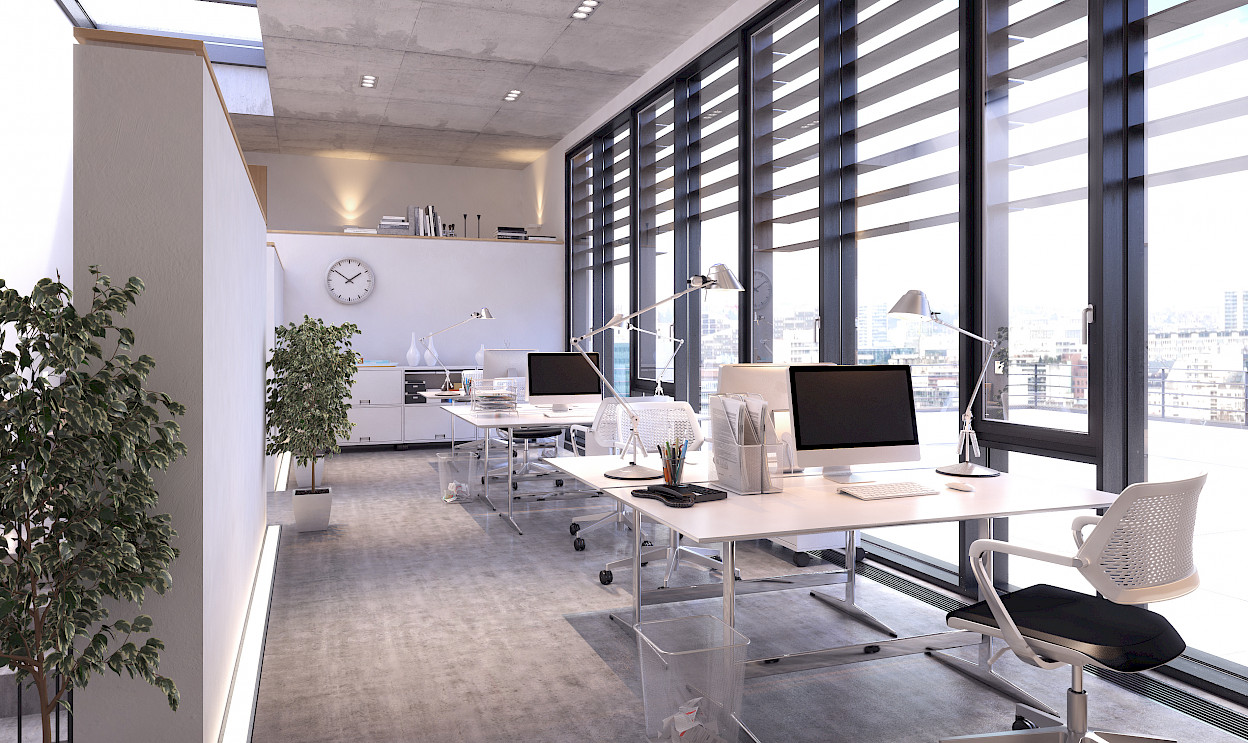It’s a well-known fact that architecture—buildings and their furnishings—makes a lasting impression on job applicants. Just like the people who are the first ones to greet the job applicants, architecture also communicates signals. Is this a company that values communication and teamwork? Where are the bosses sitting—way up on the fourteenth floor, or in the midst of the team? The less information a job applicant has about a company and the less work experience he or she has, the stronger is the effect of such signals.
The design of the study
On the basis of their research in the relevant literature and a survey of 1,144 companies, the authors of the study identified three cornerstones of the new working world:
- People (employees)
- Place (the work environment)
- Technology (technologies)

Radermacher and Schneider asked 172 students to sort ten fictional job vacancies according to their attractiveness. Each job offer included photos and descriptions of the future work environment as well as information about career opportunities and further education programmes. The achieveable starting salaries for these jobs were €36,000, €41,000 and €46,000, respectively.
Architectural styles
In order to represent the individual work environments realistically, the research team had previously analysed the buildings of companies on the DAX-30 stock exchange and winners of the Great Place to Work Award. The complete data of 41 companies was available for the study. On the basis of an analysis of this data, three architectural clusters were formed.


The harmonious-modern type of architecture
is characterized by a rather functional building façade with structural elements that are understated in terms of their form, colour and materials. The vertical and horizontal dimensions of the buildings are balanced. The interiors of these buildings are characterized by many readily accessible areas that offer opportunities for interaction and communication. The furniture, shapes, and colours are selected in order to communicate a sense of well-being. Nonetheless, the focus of the architecture is on its functionality.
The traditional-solid type of architecture
is characterized by a closed façade and a vertically oriented building structure. The interaction areas are located in closed spaces. The office workstations are mainly located in larger areas.
The fun type of architecture
largely consists of open interaction areas. Integrated fun and leisure elements dominate the style of the interaction zones.
The harmonious-modern type and the traditional-solid type of architecture were incorporated into the job offers. By contrast, the fun type of architecture was not taken into account, because it is not very widespread to date, at least not in Germany.
The results
The harmonious-modern type of architecture was the one preferred by all of the test candidates. In order to work in an environment characterized by this style, the students were prepared to forgo, on average, approximately 10% of the possible entry-level salary. As expected, job seekers without any job experience tended to make bigger concessions than older students who had already had initial career experience.

In a comparison of the job applicants’ fields of study, the students in social studies made the biggest concessions regarding salary, followed quite closely by the business management students. By contrast, for the students in the fields of engineering and IT, an attractive work environment was, on average, worth “only” about 8% of their salary.
The conclusion of the researchers
Job characteristics such as employees’ autonomy regarding their work activities and a working atmosphere that tends to be less hierarchical can be expressed by a company’s architecture. As a result, the new design or redesign of buildings and office facilities can “establish a previously hidden value in the employer branding process. Architecture can be used as a signal to young people, makes it possible for them to identify more closely with the company, and can stimulate the employees’ creativity.” [1]
[1] Radermacher, K./Schneider, M.R.: Potenzial der Unternehmensarchitektur im Rahmen des Employer Branding (The Potential of Corporate Architecture as Part of Employer Branding). PERSONALquarterly 04/17, 10–16.
Information about the study
The study was published as: Radermacher, K./Schneider, M.R./Iseke, A./Tebbe, T. 2017 Signalling to young knowledge workers through architecture? A conjoint analysis. German Journal of Human Resource Management: Zeitschrift für Personalforschung, 31 (1): 71–93
—-
Photos in this post: Bim / iStock-466108949, skynesher / iStock-1072035598, imegastocker / iStock-477878603, Christian Hillebrand / AdobeStock_59531145
Diagram: IBA




